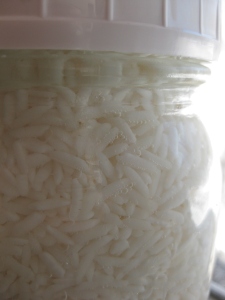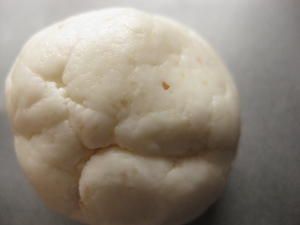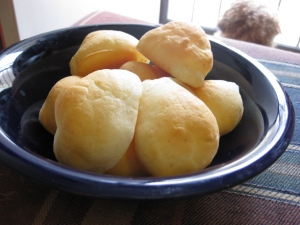When I was a teenager, I was diagnosed with a particular food intolerance by our naturopathic doctor. I had had chronic eczema on my face for over a year, as did my younger sister on her arms and neck, and so we drove over 10 hours to see this particular doctor who had a unique way of looking at allergies and intolerances. He diagnosed my intolerances as eggs (any part thereof) and grain/dairy combinations. I was told I could have either grain or dairy, but not both within 6 hours (gastric emptying) of the other. So for the next 10 years, I followed his suggestions, with complete healing of my complexion issues and also massive improvements in gastro-intestinal health issues. I was actually unaware of my issues in the digestive department until I actually abstained from those foods and could tell within an hour if prepared foods actually had something I wasn’t allowed to eat in it. Well, eventually I came across the nutritional book, Nourishing Traditions, which teaches the Weston A. Price diet. The WAP diet holds that grains are easier to digest and more nutritious when they are fermented, soaked and/or sprouted (1,2, 5, 6, 7, 8, 9). So it was with much caution that I decided to start dabbling in these alternative preparation methods and testing them on myself in the presence of dairy products. My first success was with sprouted wheat bread. After 10 years, can you even guess how much I just wanted delicious grilled cheese sandwiches?!
My second experiment was with fermenting grains. I am happy to say that this also seems to be a great success! This greatly improves my food budget as well, as I can now plan meals with economically bought grains that just need a little preparation.
Regardless, I wanted to share with you my routine with fermenting rice. I fill a quart Mason jar with rice up to the shoulder of the container, including about ½ cup from a previous ferment. If you don’t have a previous ferment, use a splash of raw apple cider vinegar, raw kombucha, raw kombucha vinegar from an overactive continuos ferment, or some whey which drains off of your plain yogurt or sour cream. I cover the rice with filtered water. I cap the jar and shake it around a bit until I can tell that some of the foggy water of the previous fermentation has made its way into the new water added. Then I open the lid again and add more water to rinse any grains off of the walls above the water line, and to bring the water level to about where the cap threads start. I place the jar on a dishcloth, in case it overflows due to carbon dioxide production, and let it sit on my counter for a couple of days, or even weeks, as long as you pour off and replace the water above the line of the grains daily. As long as I see the little bubbles around the grains in the jar, I know that the rice is fermented enough for me.
When I am ready to make my rice, I keep track of how much rice I take from the jar, which is easy since Mason jars have measurements along the side of them. I spoon the rice into a mesh colander and rinse it thoroughly, before putting it in an adequate sized saucepan. If I want sticky rice, I add an equal amount of filtered water. If I want something more al dente and very separated, I will put my rice in a steamer basket, and only steam it. Usually, I add a little less than an equal amount of water to rice. So if I am cooking 2 cups of fermented, uncooked rice, I add about 1 ¾ C. water, or a combination of water and coconut cream or broth. I also add salt. I throw the ingredients all in the pan at the temperature they happen to be, and turn the stove up until it boils, I put a lid on it and reduce the heat to simmer. I don’t think it even takes 10 minutes, but the length of cooking also has to do with personal taste and the dish you are preparing it for.
Easy Fermented Rice
3 Cups rice
1 quart mason jar with lid
Filtered water
Choice of starter- previously fermented but not rinsed rice, raw apple cider vinegar, raw kombucha, raw kombucha vinegar, or whey from cultured yogurt or cultured sour cream
salt
Directions: Fill mason jar with rice and starter up to the 3 Cup measurement line. Fill to top of grain with filtered water. Cap and vigorously shake about 6 times. Place upright, uncap, rinse with additional water and stray grains that are now above the water line or on the cap into the jar. Fill with water up to the bottom of the threads. Cap jar again. Place on dishtowel, on counter until small gas bubbles are visible around grains (about 2-4 days) while changing out the water above the grain line daily. Note measurement level of fermented grain. Scoop grain out into a mesh sieve and rinse the rice thoroughly, while leaving at least ¼ Cup of unrinsed fermented grain for a starter for your next batch in the jar. Note the amount of rice you removed as you will want slightly less than an equal amount for cooking. After rinsing, move rice to a non-reactive saucepan and add salt & water. Bring to boil, reduce heat to simmer & cover until cooked according to your preference.
Enjoy!!!
References
1) http://www.westonaprice.org/health-topics/living-with-phytic-acid/
3) http://www.nourishingdays.com/2012/01/fermented-grains-the-perpetual-soured-porridge-pot/
4) http://www.foodforlife.com/about_us/ezekiel-49
5) http://www.tandfonline.com/doi/abs/10.1080/10408398909527507#.VMsIJy5K4no
6) http://www.sciencedirect.com/science/article/pii/S0740002009001749
7) http://jn.nutrition.org/content/130/8/1991.short
9) http://www.sciencedirect.com/science/article/pii/S0308814608002513







